mytest
eBooks, Books, and more from Dr. ARUDOU, Debito (click on icon):
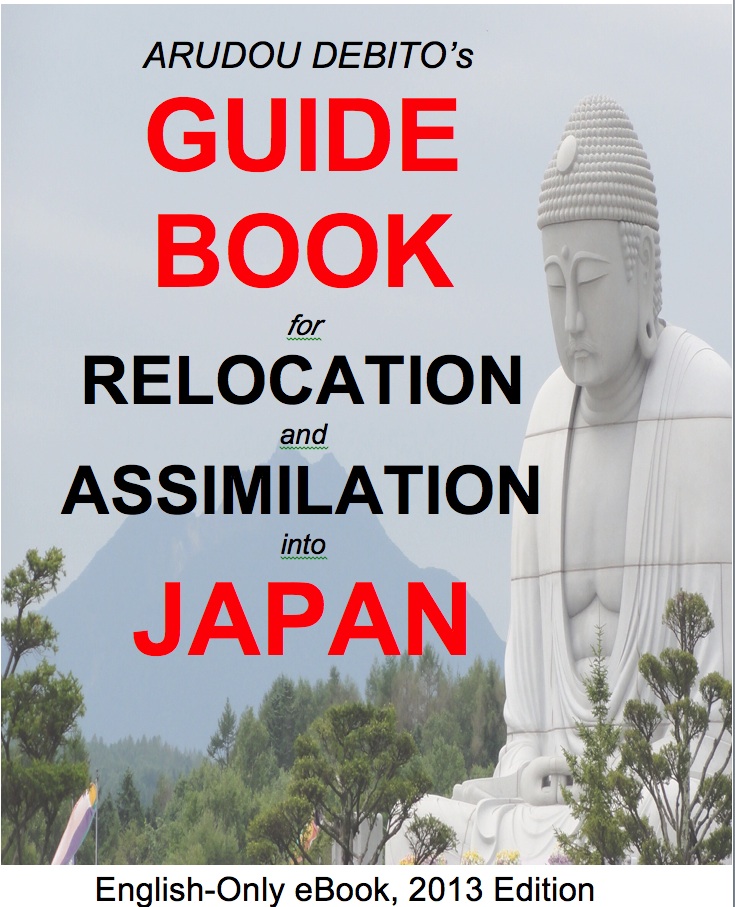
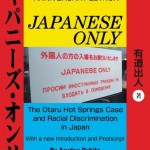
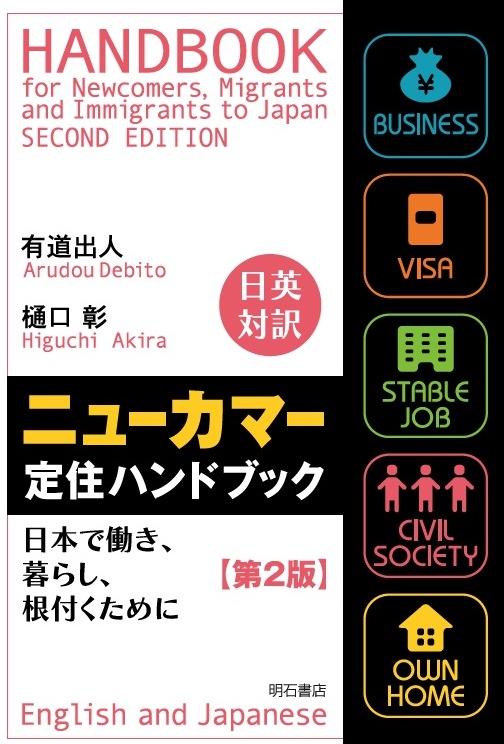
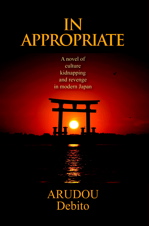

![]()


UPDATES ON TWITTER: arudoudebito
DEBITO.ORG PODCASTS on iTunes, subscribe free
“LIKE” US on Facebook at http://www.facebook.com/debitoorg
http://www.facebook.com/handbookimmigrants
https://www.facebook.com/JapaneseOnlyTheBook
https://www.facebook.com/BookInAppropriate
If you like what you read and discuss on Debito.org, please consider helping us stop hackers and defray maintenance costs with a little donation via my webhoster:

All donations go towards website costs only. Thanks for your support!
Hi Blog. To celebrate Debito.org’s 2500th Blog Post (not including all of the other sites for example here, here, and here in the ten years before the blog was established), I am proud to have the privilege of putting up two important speeches by friend and colleague Dr. M.G. “Bucky” Sheftall of Shizuoka University, author of “Blossoms in the Wind: Human Legacies of the Kamikaze” (Penguin, 2005)
These speeches were given on April 10 and 11, 2015, to commemorate the opening of a temporary exhibit of historical artifacts and records of “Kamikaze” suicide pilots. This important exhibition is currently below decks for at least the next six months aboard the USS Missouri (yes, the site where Japan surrendered and ended WWII), anchored at Pearl Harbor, Honolulu, Hawaii. It is open to the public, featuring things from the Chiran Peace Museum near Kagoshima, Kyushu, never before seen outside of Japan. I was in attendance at both events, and it made several US newspapers (the front page of the Honolulu Star-Advertiser (subscription only), on Hawaii NewsNow, and the Los Angeles Times, inter alia) as well as some Japanese media. The ceremony itself took place on the 70th Anniversary of a suicide pilot colliding with the Missouri (its bomb did not explode), with many people on both sides of the Pacific in attendance.
I’ll let Bucky tell the rest of the story. First the shorter speech of April 11, then the longer one with more context and intents of April 10. Read and have a think about how some people are wresting control of Japan’s wartime narrative into a less jingoistic direction. Dr. ARUDOU, Debito
///////////////////////////////////////////////////
SPEECH BY MAYOR SHIMO-IDE OF CHIRAN, MINAMI-KYUSHU CITY, KAGOSHIMA. TRANSLATED AND READ BY DR. M.G. “BUCKY” SHEFTALL
USS MISSOURI, HONOLULU, HAWAII, APRIL 11, 2015
戦艦ミズーリ記念館 セレモニー 市長挨拶
Ladies and gentlemen, Aloha, good morning, ohayo gozaimasu.
First, on behalf of the city of Minamikyushu, Japan, I would like to thank the Battleship Missouri Memorial and its staff for giving us this opportunity to exhibit artifacts from our city’s collection of kamikaze pilot letters and personal effects in this historic and symbolic place.
Seventy years ago, our two nations were at war with one another.
Seventy years ago to this very day, on April Eleventh, Nineteen Forty-Five, a nineteen-year-old Japanese kamikaze pilot crashed his aircraft into this ship — only a few yards from where I am standing. But even in the midst of bitter war, even as lookouts scanned the skies for more attackers, the captain and crew of the Missouri held a military funeral for the dead pilot with honor and respect.
Seventy years ago, the captain and crew of the USS Missouri were able to recognize humanity shared with a fallen enemy. I believe that spirit lives on in this ship, and that it is what allows us to gather here today on the occasion of the opening of the first exhibit on kamikaze history ever held outside of Japan, triumphant over the bitterness and hatred our nations had for one another in a past still within living memory.
In the last months of the war – a war which started with an attack by Japan upon this very spot in 1941 – our town saw off many, many kamikaze missions. It is regrettable that we cannot undo a past in which our two countries were once at war. But now, seventy years later, through this historic exhibit at the Battleship Missouri Memorial, we are provided with an opportunity to stand together steadfastly and look back upon that past in a spirit of reconciliation and mutual understanding.
President John F. Kennedy once said “Mankind must put an end to war, or war will put an end to mankind.”All of us gathered here today, and everyone else on this planet, wants peace on earth. And certainly, all of us share from the bottom of our hearts the hope and the prayer that the human race never again sees a war on the scale of destruction and ferocity of the bitter conflict between our two countries seventy years ago. I sincerely believe that this exhibit represents a step, even though maybe only a small step, in the cause of peace not only for our countries, but also for East Asia and the world as a whole.
Finally, I would like to thank the president, curator and staff of the Battleship Missouri Memorial and everyone else who, through their patience, cooperation and great efforts, have helped to make this exhibit possible. Together with my prayers for the success of the exhibit, I also offer my sincerest gratitude. Thank you.
ENDS
///////////////////////////////////////////////////
Kamikaze Lecture April 10, 2015
Written and delivered by Dr. M.G. “Bucky” Sheftall
USS Missouri, Honolulu, Hawaii
Ladies and gentlemen, Aloha, and mahalo for inviting and joining me here this evening. I would like to give a special mahalo to the hard work and generous hospitality of the Battleship Missouri Memorial staff in providing this spectacular and profoundly historic and symbolic venue for my talk, in which I will try to put into appropriate context two events of direct relevance to why we are gathered here on the fantail of this legendary warship.
One of these events involved a 19-year-old man – a boy, really – named Setsuo Ishino crashing a Mitsubishi Zero fighter plane in a kamikaze attack against this ship, hitting it about twenty yards from where I stand, exactly seventy years ago to the day tomorrow. I have spent the past fifteen years of my academic career attempting to figure out why thousands of sane, rational young Japanese men like Ishino did what they did, and were able to do what they did, in 1944-45. And make no mistake about it, as you will see when you read their letters later on when we go belowdecks to see the exhibit, these young men WERE sane and rational – I believe it was rather the circumstances into which they were thrown in 1944-45 that were insane, and irrational.
I have also studied why and how those young men could be ordered to do what they did by ostensibly sane and rational senior military professionals.
Likewise, I have tried to figure out how the populace of an entire nation – in full knowledge via Japanese state mass media at the time of exactly what the “kamikaze” concept entailed, in all of its tragic, gruesome details – could cheer the kamikaze pilots on for the last ten months of the war, sure to the very end that the kamikaze campaign waged by both the Imperial Army and Navy was sure to miraculously rescue them and bring the nation a glorious victory even as Japan’s cities were being burned to the ground every night by American B-29s. To put that era of magical thinking in sharper perspective, during the ten months that constant news headlines and stirring radio broadcasts about the kamikaze gave the Japanese nation the will and hope to keep fighting on in their lost war, approximately half of Japan’s two million military fatalities in the entire conflict and the vast majority of its civilian fatalities were suffered.
In the limited time we have this evening, I hope I can shed at least a little light upon – and do justice to the weight of – the extremely complex issues related to the kamikaze phenomenon, none of which can in any case be explained with single, simple answers.
The second relevant event I would like to put in proper context is about to happen, also tomorrow, and also on this ship, but several decks below the spot where young Setsuo Ishino’s Zero hit the Big Mo. And here, I am of course referring to the “kamikaze artifacts” exhibit featuring letters, uniforms, and other personal effects of kamikaze pilots – the first exhibit of its kind ever held outside of Japan – that will open here at the Battleship Missouri Memorial tomorrow morning.
Before proceeding, I would like to make a note regarding terminology. I am aware that the term “kamikaze” is pretty much standard around the world – outside of Japan, that is, where it is eschewed for various reasons – for describing the late-war Japanese military tactic of the deliberate crashing of aircraft into targets. However, in the interest of historical accuracy, of avoiding stereotypes fossilized by decades worth of lurid Sergeant Rock comic books and tacky slang usage, and most importantly, at least for me, in the interest of ease of elocution, for the rest of my talk, instead of the term “kamikaze”, I am going to use the phrase “tokkō”, which is a Japanese abbreviation of the euphemistic military expression “tokubetsu kōgeki” or “special attack”. So, from hereon out, it’s not “kamikaze”, but “tokkō”. Everyone on board with that?
So, let’s move on to what I’m pretty sure is the first question about tokkō that is probably at the front of everyone’s mind this evening, NAMELY, “Why did they do it?” That is a simple and quite reasonable question to which there are, unfortunately, and at risk of repeating myself, no simple and reasonable single answers. This issue is so complex that, in my fifteen-odd years of study dedicated to it, I think I have barely scratched its surface, and I doubt I will ever figure it all out. Actually, I doubt anyone ever will or can. Nevertheless, I will try to share with you now a summary of some of the fruits of all of that surface-scratching the Japanese taxpayer has been paying me to do for the past fifteen years.
First and foremost, tokkō should be approached from the perspective of brute military expedience. By the time the Japanese military began deploying tokkō, it had already endured a nearly two-year-long steady stream of military defeats and setbacks since the heady period of initial Japanese successes in the first 12 months of the war.
One specific development in the overall dire military situation which had direct influence on the eventual deployment of tokkō was Japan’s near complete loss of air superiority – or even anything approaching air parity — in just about every theater of operations against Allied forces from at least early 1943 on. This loss of air superiority extended to the Japanese Home Islands themselves by late 1944. This turning of the tide of the Pacific war in the air can in large part be credited to new American fighter designs such as the Grumman Hellcat which were not only superior to but in fact specifically designed to destroy the previously overwhelmingly dominant Japanese fighter types. But most credit in this case must be given to the sheer economic and strategic inevitability of what was bound from the start to happen to Japan’s war fortunes when America’s industries tooled up to full war emergency power, so to speak, and the American populace mobilized itself psychologically and steeled itself emotionally for a long, brutal fight against a determined enemy the final outcome of which was nevertheless never in question even when oil fires and burning warships blackened the skies over this very spot on December 7, 1941.
Of course, in an aviation-dominated conflict such as the Pacific Theater, the loss of air superiority was, at the risk of gross understatement, a critical setback for the Japanese military – particularly the Imperial Navy and Merchant Marine, upon which the new Japanese Empire was even more dependent than the old British Empire had been upon its own maritime resources. Without the ability to put up a decent fight in the air, Japanese forces could neither take the fight to the enemy nor adequately defend themselves when the enemy took the fight to them – something that was happening with increasing frequency and intensity from early 1943 on. When Japanese surface vessels sortied out to close for combat, they were as often as not sunk by Allied aircraft before they ever saw an enemy warship. Without the ability to put up solid resistance in the air, the Japanese military could neither stop nor even significantly slow down the Allied fleets that were breaching the ramparts of the Japanese Empire on all fronts and beginning to close in on the Japanese Home Islands themselves by late 1944, when the tokkō tactic made its official debut at the Battle of Leyte Gulf in the Philippines in October of that year.
When Western writers attempt to address the issue of tokkō, their approach all too often has a vaguely patronizing, Rudyard Kipling-esque, almost touristy feel to it – a tendency to draw facile parallels to the samurai ethos and the like – lots of misty imagery of mountaintop Zen temples and harakiri scenes and purple prose about cherry blossoms and such – in other words, to write the tokkō phenomenon off to a case of some kind of exotic, inscrutable Japanese weirdness. I do not approve of this trope in Western writing on the subject of tokkō, and have always tried to avoid it unless I am mentioning it in the specific case of wartime Japanese propaganda’s prodigious efforts to sell the tokkō concept to the general public and to the military rank-and-file using similarly flowery and self-exoticizing imagery – portraying tokkō as something springing up naturally from some native, ancient, magical samurai spirit in the Japanese soul – as opposed to being something mapped out as a desperation tactic in a naval planning room and ordered to be performed by adolescent pilots who had no choice in the matter of their personal fate. Yes, if I were a 1944 Japanese propagandist tasked with selling the tokkō concept to the Japanese public, I certainly would have opted for the misty mountain cherry blossom samurai imagery, too. As stirring PR, it’s brilliant.
So, minus all of the “East is East, West is West, and never the twain shall meet” boilerplate, and keeping our emotive adjectives and adverbs to a bare minimum, what was tokkō was all about?:
From October 1944, the Imperial Japanese military – choosing to continue fighting in a combat environment in which air superiority had been completely and irretrievably ceded to the enemy – began fielding what were, in dispassionate, brutally frank terms of intended tactical utility, guided anti-ship missiles. The technology that could be applied to these “guided missiles”, however, was limited to what was available to the Japanese military in 1944-45.
Technological limitations, the exigencies of a rapidly deteriorating tactical and strategic situation, and perhaps, the temptation of having on hand a ready supply of young men that were – thanks to three generations of intensive state education for this very role – capable of any sacrifice (or at least incapable of refusing orders to make any sacrifice) for their cause – all had direct bearing on the decision to commit to tokkō. With the luxury of such human resources at hand, Japanese planners reached the conclusion that a human brain and body – i.e., a pilot – comprised the most pragmatic and effective option available for the target acquisition and guidance control system necessary for this anti-ship missile, while a bomb-laden high performance military aircraft was regarded as the most practical choice for its ballistic component. “Successful” deployment of the weapon, of necessity, involved the inevitable destruction of the human “guidance system” when the “missile” was crashed into its target – generally an Allied warship. The Japanese military had these resources at hand in 1944-45, and they were used to pursue the war effort.
Now, all of this raises a second very important question, namely, “Did anyone in Japan try to stop the decision to go all out on tokkō tactics?” There was, initially, a measure of opposition within the military to the expenditure of human lives in such a horrific manner – even Vice Admiral Takijiro Ohnishi, who would go on to be the first flag officer to give tokkō orders in the field, went on record in a high level Tokyo naval strategy meeting as being opposed to using men and aircraft in this manner when the concept – which Ohnishi initially called tōsotsu no gedō or “military apostasy” — first began getting airtime in high-ranking naval circles after major defeats at Guadalcanal and the Aleutians.
However, the general panic in the wake of the fall of Saipan in 1944 – now putting Japan itself within range of B-29 bases which could not be neutralized by Japanese land forces (unlike US bases in China) – the success of the tokkō tactic’s debut at Leyte Gulf, and perhaps of equal importance, the extreme ingroup conformity and groupthink that characterized Japanese military culture of the era, are all factors that contributed to the silencing of most would-be critics of tokkō. From then on until the end of the war it was acknowledged by the overwhelming majority of field commanders in both the Imperial Navy and Army that the new “guided anti-ship missile” was capable of accuracy and destructive power far greater than what was by then considered obtainable with conventional air tactics against superior Allied forces. As the thinking at the time went, if all of the nation’s military pilots were going to be killed anyway in lopsidedly unequal air combat, why not make their deaths count by striking powerful blows against the enemy? So tokkō was used. And once tokkō entered the public imagination via the mass media, with the military now so publicly and irreversibly committed to the tactic, no one had the nerve to try to stop the whole catastrophic process once it was set in motion. Not even the Emperor himself, who is reported to have stood and solemnly bowed in the direction of the Philippines when told the news of the first “official” tokkō deployment at Leyte Gulf.
And as far as the general populace was concerned? As I intimated previously, the tokkō pilots were collectively presented to the public – and received rock star-like adoration from that public – as dashing young heroes. The mass media record of the era makes unquestionably clear that there was a huge amount of public support for tokkō – both of the sincere and, one suspects, prudent lip-service variety – while the war was going on. No one questioned the tactic, or the sacrifice, or the meaning of it all in wartime Japanese print or broadcast.
For the most part, young, usually unmarried pilots with little or no previous combat experience carried out the tokkō missions. By war’s end, some 5,843 of these young men, many if not most as “volunteers” in name only, had died in tokkō attacks (the vast majority of these aerial tokkō attacks as opposed to manned torpedoes or suicide motorboats) that sank or damaged over 200 Allied ships and killed or wounded approximately 15,000 Allied servicemen, also resulting in the highest rate of psychological casualties – then referred to as “combat fatigue”, and what would today be referred to as PTSD – ever seen before or since in the history of the American armed forces.
So, what do the Japanese think of the tokkō legacy now?
Even though tokkō casualties amounted to less than one percent of the total Imperial Japanese Army (IJA) aviation casualties and only a slightly higher fraction of Imperial Japanese Navy (IJN) aviation casualties during the war, the tokkō legacy has continued to be a tremendously symbolic and emotionally powerful feature of the postwar Japanese psychological landscape. The existence of a Japanese institution such as the Chiran Peace Museum, which has cooperated in putting together the exhibition here, is proof of the symbolic and emotional power the tokkō legacy continues to have in Postwar Japan, and proof, perhaps, that this legacy has yet to be completely worked out in popular Japanese historical consciousness. This is true not only for Japanese whose lives were personally and directly affected by tokkō during the war, but I think for all other Japanese since. While it is clear that tokkō was and continues to be something of which millions of Japanese are proud (and one suspects this sentiment is publicly expressed with varying degrees of sincerity and conviction, and privately embraced with varying degrees of cognitive dissonance involved), it is also clear that the tokkō legacy poses a weighty belief dilemma in Japanese discourse regarding national identity – both during and since the war.
Specifically, the essentially overlapping legacies of tokkō-as-historical legacy and tokkō-as-real-time-official military policy have posed particularly hard questions in the following areas: firstly, about the moral implications for those involved in conceiving, carrying out and or otherwise supporting the tokkō campaign in real-time; secondly, about how the tokkō legacy will and SHOULD be treated by historical posterity; and lastly, about how this legacy should be explained (if at all) to current and future generations of Japanese young people. The tokkō legacy might even be said to raise – and I believe it should be ALLOWED to raise – hard questions about the nature and responsibility of a society and political system under which such a tactic could be conceived and executed by its leadership, unquestioningly obeyed by the military rank-and-file, and enthusiastically supported to the degree that it was by that society’s members.
Frankly, I do not think most Japanese want to see Japan become a country like that again – either willingly, out of some kind of misguided cultural nostalgia, or forced to become so by circumstance – with the nation backed into a corner again like it was in 1944-45. And I KNOW no OTHER country wants to see Japan become like that again. The efforts, cooperation, generosity, and moral courage of the city of Minamikyushu and its Chiran Peace Museum in helping to put this exhibition together at Big Mo are proof aplenty that there are movements afoot in Japan to begin the necessary and long overdue process of negotiating explanatory narratives about Japan’s war experience that are acceptable not only for certain domestic Japanese niche audiences, but which are acceptable globally, as well, including with former enemies the loathing and fear of whom still exist in living Japanese memory. These developments and the aspirations for world peace they entail can ONLY have positive consequences for Japan, for the region of East Asia, and for Japan’s national image around the world. It is win-win for everyone involved. Through this reaching out to a former enemy in this literally historically unprecedented exhibit, Chiran is blazing a trail – it is showing the rest of Japan – and ALL OF US – how it can be done, how a commitment to remembering the past can and must put to rest, once and for all, simmering, lingering resentments and hatred about that past. And we are all the better off for these efforts. As you join me below decks later, I ask that you keep that idea in your mind as we explore this exciting new exhibit, and to also keep in mind the idea that you can acknowledge another human being’s humanity and honor his memory and sacrifice without being compelled to glorify, rationalize, or romanticize the cause for which he was sacrificed or, and this certainly applies in this case, without being compelled to attempt to glorify, rationalize, or otherwise romanticize the manner in which that sacrifice was made. Captain William Callaghan and the crew of the USS Missouri taught us as much not twenty yards away from where we are gathered, 69 years and 363 days ago. It is a lesson we should never forget. Thank you for your attention this evening.
ENDS
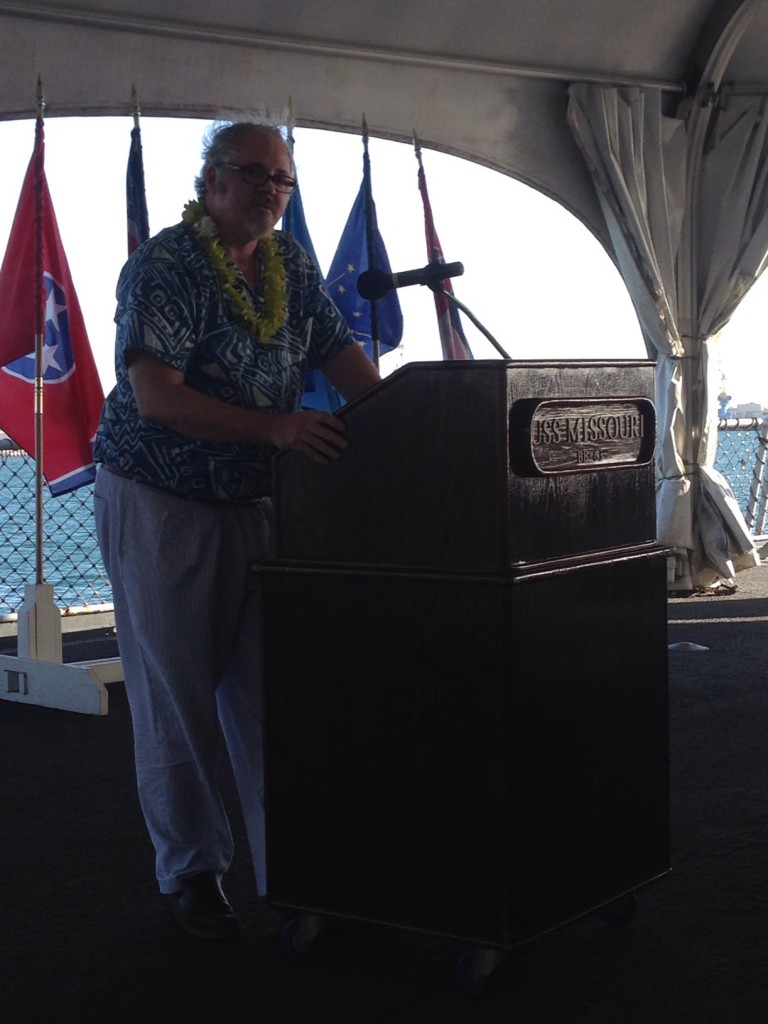
11 comments on “Post #2500: Dr. M.G. “Bucky” Sheftall’s speeches at the opening of “Kamikaze” suicide pilots exhibit aboard USS Missouri, Apr 10 and 11, 2015”
Thank you for posting this Dr. Debito.
Dr. Bucky really knows his stuff, and his excellent speech helped me verbalize something I find really disturbing about the official narrative for remembering the war, and it’s this;
Whether its defending revisionist textbooks or visiting war criminals at Yasakuni, the official narrative is that ‘these (Japanese) people sacrificed their lives to create modern Japan’.
This is a gross and offensive distortion of fact and logic to me.
Modern Japan wasn’t created because of thier sacrifice, but rather in spite of it!
Those Japanese who were forced to die by leaders controlling a society that brainwashed or otherwise coerced them to die were doing so with the aim of winning the war, continuing Imperialism, and preventing the creation of the Japan we know today.
Dr. Bucky talks about suicide pilots being portrayed now and then as patriotic volunteers when in reality they had no choice, whilst the populace is forced to support them for lack of ability to object.
This is one aspect of reality that the post-war narrative of ‘they sacrificed themselves to create modern Japan’ intentionally seeks to conceal;
They didn’t sacrifice themselves, they were sacrificed. Sacrificed along with millions of other Japanese soldiers and civilians.
As if that wasn’t bad enough, the official narrative serves to conceal a second truth;
The war-criminal leaders of wartime Japan gave not a hoot for the people or the country (or the country’s future), but rather were so in thrall to the propaganda myth of ‘Japanese uniqueness’ that they were unable to consider surrender even when the writing was on the wall in ’44.
Protecting the idea of ‘Japanese uniqueness’ was such a deeply rooted imperative that even the total annihilation of the Japanese nation in their Shinto emperor death cult would have been preferable to changing thier world view.
The Japanese government was afraid that the Americans would either punish/execute Hirohito or get rid of the royal family.
Tojo was the fall guy for Hirohito.
The lives of ordinary Japanese did not matter.
Kamikaze attacks may have persuaded the US government to just go with the atomic bombs, and avoid combat in Kyushu.
My wife’s father was just a poor man in Shimane who was drafted and had to go to Thailand. He worked in intelligence gathering. Later he was sent to the Philippines. He got sick and then was discharged. At least he got to be buried in Japan. He died for nothing.
It is really terrible that people in Japan do not learn enough about Japan’s involvement in WW2. The Germans do a much better job at that.
Wow. How profound.
Sorry, I meant my wife’s grandfather.
When I visit my in-laws I get to look at his picture on the wall.
I really wonder what he had to go through.
Theres a swipe at Abe in here-” I do not think most Japanese want to see Japan become a country like that again – either willingly, out of some kind of misguided cultural nostalgia, or forced to become so by circumstance ”
Misguided nostalgia indeed. Also he covers the China/Korea angle that “Japan as victim” mongers would doubtless raise-” And I KNOW no OTHER country wants to see Japan become like that again. ”
There really is no excuse for Abe’s revisionism or this misguided nostalgia. I would say Miyazaki’s “The Wind rises” is a prime example, although there are several Japanese war movies out recently all seen from “the Japanese point of view”. Consider the title and the subject matter (The Zero) and yet there is precious little about the Kamikaze. Its probably too distasteful for Miyazaki.
So I am not sure if all Japanese are “proud” of them, as Bucky states.
“A group of Zeros fly past and their pilots salute Jiro. “Not a single one returned,” Jiro sadly remarks. Caproni comforts him, saying Jiro’s dream of building beautiful aircraft was nonetheless realized, though they are ultimately “beautiful, cursed dreams waiting for the sky to swallow them up.”[17]” wikipedia.
They didnt return because they were sacrificed.
@ Brooks, #2
‘It is really terrible that people in Japan do not learn enough about Japan’s involvement in WW2.’
I agree. But i think that this whole thing about not surrendering earlier because they wanted assurances about keeping the Emperor, is kind of a red herring. It makes the wartime leaders look like ever so good patriots. This has assumed massive importance in the postwar period, and I believe is used to deflect blame for not surrendering earlier onto the US for having not given Japan assurances about the Emperor.
Whilst the Emperor may have been a consideration, the reason that the Japanese wartime leaders rejected unconditional surrender in ’44 (and thereby subjected Japan to US fire bombing) is that the Japanese were seeking a conditional surrender with the US that would allow them to keep China.
It doesn’t suit the post-war revisionist narrative that big business wanted the resources of China so bad that the Japanese leaders would sacrifice millions of Japanese civilians and soldiers to keep it.
Ultimately, then as now, the needs of the Japanese people were totally subordinated to the needs of the ‘erai hito’- big business, and the politicians who were vested in it.
This feudal relationship between Japan’s ‘erai hito’ and the masses was severely disrupted by GHQ’s writing of a new constitution for Japan, and that’s exactly what Abe has decried as being ‘incompatible with traditional Japanese values’, and why he seeks to overturn it. His explicit goal is to return to these feudal social relationships. The ‘erai hito’ can get back to abusing the human rights of the Japanese, and create a legal framework that criminalizes opposition.
Yes, they wanted a conditional surrender.
They waited and Truman got impatient. The army and navy could not agree about what to do and dithered.
The bombs in Hiroshima and Nagasaki pressed the issue.
Who knows what FDR would have done.
Abe is hard to figure out. His grandfather (Kishi?) went to jail but got let out.
I think he was at Sugano.
Abe is for the US military in Japan, but in some ways it is like he wants to go backwards, to the past.
I kind of wonder what Abe is going to say when he addresses the US Congress. Probably lots of tatemae.
I can say that at least my father teaches about the Japanese internment in his US survey class in Vermont.
He is a professor of American history, and a graduate of Cornell.
I heard that some Japanese high school history teachers run out of time and breeze through WW2,
and that high school students can choose world history instead of Japanese history class.
I think Japanese history should be mandatory.
@ Brooks #7
Yes, the A-bomb program did indeed have a momentum of it’s own, and served as a warning to the Soviets and the start of the cold war as much as ending WWII.
Kishi was in Sugamo, and is on record as saying he would have died in prison if he were not released as part of the ‘reverse course’.
‘Abe is for the US military in Japan, but in some ways it is like he wants to go backwards, to the past.’
Abe’s position is easier to understand if you start from the position that Okinawa and the Okinawan people are not seen as ‘proper’ Japanese in much the same way that they weren’t in WWII (hence they were sacrificed to the US invasion). I believe that the right wing shares this view of Okinawa as second class citizens (hence riding rough shod over elected local officials re; the base re-location plan). If we accept the premise that Okinawans and Okinawa are not ‘proper’ japan, then you can see why Abe seems to be contradictory (when in fact he isn’t).
You see, by keeping the US in Okinawa, he can stand on his nationalist soap box about being ‘occupied’ and not a ‘normal country’, and push for constitutional reforms to remilitarize the nation. At the same time, the alliance allows him to mouth off at pretty much all of Japan’s neighbors, and thumb his nose at the, because the US has got his back to deter the neighbors from giving him a slap down.
This is perfect for Abe. The very last thing he wants to do is agree that Okinawa shoulders too much of the burden of hosting US forces that protect Japan, and agree to a relocation to a new base within the four main islands. As I’m sure that you can imagine, if the US military moved back to Honshu (for example), the nationalists would feel ‘occupied’ again. They would see it as a step back, and that would leave them and Abe feeling humiliated.
Okinawa isn’t ‘really Japan’, so Japan isn’t ‘really occupied’, by their reasoning.
@ Brooks, Abe is easy to figure out. He has “little man” syndrome, a chip on his shoulder, and wounded family pride. Natch, he is an LDP blast from the past-I could swear he is the second coming of “Slick” Hashimoto, perhaps they are related- who probably had a great time in the 80s, as “Japan is number 1” was the mantra back then. He is nostalgic for those glory days and in a weird echo of those times, in the TTP talks “Japan is tough with the USA on the rice issue”.
WTF? The Rice issue? I checked the date and no, this wasn”t a “in the 80s on this day” re-run, this was new.
Abe is the bad side of Japan, the annoying guy we used to meet who would ruin our enthusiasm for things Japanese in the 80s with some uncalled for racist/misogynist/revisionist/We Japanese comment. Then some friend/wife/lackey/japologist would say something like “I am sorry but he doesnt like/do business with gaijin”, as if the whole thing could be excused away just like that.
A comment on another blog says how beautiful Japan is, how they want to visit… and then the Abe war denial dark side really ruins it for tourism.
The Japanfocus link on another thread here points out how Abe and the Rightists should really just shut up about WW2-that they cannot erase other countries’ memories of war and in fact it is just holding a red flag up to China and Korea-why do this?
It is just tarnishing Japan’s reputation and Abe cannot win this argument.But he just can’t stop, because of his personal shortcomings and personality disorder, coupled with an overwhelming desire to “prove himself right” to the World, or at least to America, who he needs, but whom he risks alienating-but whom in his fantasy would support his adventurism against China, etc.
Just an insecure little man, really. Who takes everything personally and is hypersensitive to anything that might, in his mind, be against him. I met guys like him in the 80s- I think their whole game was to put off the gaijin making a go of it in “their” Japan.
“I want rich foreigners to come here, spend money and then leave”.
@Brooks (#7) I think and hope that the right people, i.e. foreign policy experts in Europe and the US, are not having too hard of a time of figuring out Abe. Abe is in it for the long con. He can rely on the fact that the LDP will always be in power unless there is a fully-fledged revolution going down, toppling this de-facto one-party regime. So, what he is doing today is setting up Japan to regain its reputation as the intimidating, superior culture it was around WWII. And old blabbermouth Shintaro Ishihara has already given away the ultimate goal of the nationalists.
His long “con” is to get the world and the non-right-wing Japanese to accept a nuclear armed Japan. He wants to do it under the umbrella of the US “alliance”, so China’s and Korea’s worries can easily be dismissed by saying “hey, we might have nukes now, but we have only a defensive force because the US is protecting us, so those nukes can only be used defensively”. The blatant lie of the “defense force” is, and always will probably be enough to satisfy those Japanese who are truly pacifist and anti-nuke, but China and Korea need to be introduced to the idea of Japan getting nukes very carefully and gradually.
If Japan indeed does have nukes, we will see a very quick shift into hostility towards the US and a movement to “become independent” because Japan can now “defend itself”. If that partnership ends, then all bets are off, and in my opinion another Pearl-Harbour style sneak attack, only nuclear and on China this time, is inevitable. A culture where the people in power see themselves as racially superior to their neighbours is doomed to fall back into imperialist aggression one day. Maybe it will take 30,40, or 80 years, but that’s the direction Japan is headed, in my opinion.
@ Markus #10
I am delighted to see in the news today that 25 members of Congress are asking for Abe to make an explicit acceptance of all former Japanese apologies for the war. They, at least, are wise to his mealy-mouthed practice of delivering utterances that attempt to play different messages to the international audience and the Japanese domestic audience simultaneously.
However, unfortunately, I believe that US congressional pressure will be due to a combination of Congressmen/women acting on behalf of their Korean descended electorate (as well they should), combined with bi-partisan resistance to Obama’s TPP. Obama is desperate to get a TPP deal as a legacy of his presidency. It’s all in the balance right now- Obama will be tempted to give in to Abe to get the deal but the more he does, the more TPP resistance will come back directly on Abe in terms of accepting war guilt IMHO. We will have to wait and see.
But Bucky’s speech above is very interesting. It seems to me that 70 years after the war, the Japanese still refute such crimes ever happened, whilst at the same time the concept of brutal Japanese war-crimes has become so much a part of our western culture that people are blind to it. The prime example for this is the work of Pierre Boulle.
You may not know him as a Frenchman captured after the fall of Singapore, and subjected to years of brutal Japanese captivity and forced labor. He wrote Bridge on the River Kwai.
He also wrote the original Planet of the Apes. Go back and watch that again knowing that is a metaphor for Japanese imperial rule.
— Oh my. Wow.